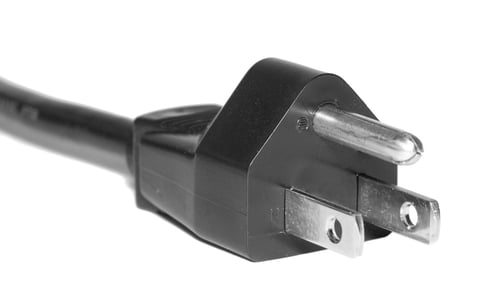A Guide to NEMA Connectors

The National Electrical Manufacturers Association (NEMA) is an industry authority in the USA, composed of more than 350 companies and with more than 700 standards and technical publications. Although NEMA is a USA-based organization, it has global recognition and its standards are used internationally. As you can imagine, power plugs and receptacles are among the electrical equipment categories covered by NEMA standards.
Before presenting the NEMA classification for power plugs and receptacles, it is important to identify the two main types:
- Straight-blade, non-locking
- Curved-blade, twist-locking
Non-locking connectors use plugs designed to be pulled in and out of receptacles freely, which is convenient but also means the plug can be easily disconnected by accident. Twist-locking connectors can be rotated once the plug is connected, causing them to latch in place and eliminating the risk of accidental disconnection.
Make sure you're using the correct power outlets in your project.
Power plugs and receptacles manufactured according to NEMA standards come with an alphanumeric code that describes product features. This article will provide a guide on how to interpret such codes.
Understanding NEMA Codes
NEMA alphanumeric codes indicate four key pieces of information for power plugs and receptacles:
|
CONNECTOR FEATURES |
DESCRIPTION |
|
Non-locking or twist-locking? |
If the NEMA code starts with the letter ‘L’, it's a twist-locking device. |
|
NEMA type |
The NEMA type determines the construction features of a connector. It is indicated by a number, which is preceded by the letter ‘L’ in twist-locking devices, and followed by a dash. |
|
Current rating |
Indicated by a number after the dash, which represents the ampere rating of the device. |
|
Plug or receptacle? |
The NEMA code ends in ‘P’ for plugs and ‘R’ for receptacles. |
As an example, assume the NEMA code of a connector is L5-30R:
- The letter ‘L’ indicates a twist-locking device.
- The NEMA type is 5 (number before the dash).
- The current rating is 30A (number after the dash).
- The letter ‘R’ indicates a receptacle.
On the other hand, a connector labeled as 2-15P would have the following features:
- Since there is no letter ‘L’, it's a straight-bladed and non-locking device.
- The NEMA type is 2.
- The current rating is 15A.
- The letter ‘P’ indicates a power plug.
Twist-locking connectors are normally used in applications where accidental disconnection is likely and the consequences are significant, such as data centers or industrial locations.
Note that power plugs and receptacles are designed for connecting the same NEMA types together; the angle between blades differs slightly among types to prevent accidental connection. For example, you cannot connect a 1-15P power plug to a 2-15R receptacle.

NEMA Connector Types
The following table describes the NEMA connector types, based on conductor properties and rated voltage. The types marked with an asterisk are only available in twist-locking versions, while the rest exist in both non-locking and twist-locking configurations.
|
NEMA TYPE |
WIRES |
HOT |
NEUTRAL |
GROUND |
RATED VOLTAGE |
|
NEMA 1 / L1 |
2 |
1 |
Yes |
No |
125V AC |
|
NEMA 2 / L2 |
2 |
2 |
No |
No |
250V AC |
|
NEMA 5 / L5 |
3 |
1 |
Yes |
Yes |
125V AC |
|
NEMA 6 / L6 |
3 |
2 |
No |
Yes |
250V AC |
|
NEMA 7 / L7 |
3 |
1 |
Yes |
Yes |
277V AC |
|
NEMA L8* |
3 |
2 |
No |
Yes |
480V AC |
|
NEMA L9* |
3 |
2 |
No |
Yes |
600V AC |
|
NEMA 10 / L10 |
3 |
2 |
Yes |
No |
125/250V AC |
|
NEMA 11 / L11 |
3 |
3 |
No |
No |
250V AC |
|
NEMA L12* |
3 |
3 |
No |
No |
480V AC |
|
NEMA L13* |
3 |
3 |
No |
No |
600V AC |
|
NEMA 14 / L14 |
4 |
2 |
Yes |
Yes |
125/250V AC |
|
NEMA 15 / L15 |
4 |
3 |
No |
Yes |
250V AC |
|
NEMA L16* |
4 |
3 |
No |
Yes |
480V AC |
|
NEMA L17* |
4 |
3 |
No |
Yes |
600V AC |
|
NEMA 18 / L18 |
4 |
3 |
Yes |
No |
120/208V AC |
|
NEMA L19* |
4 |
3 |
Yes |
No |
277/480V AC |
|
NEMA L20* |
4 |
3 |
Yes |
No |
347/600V AC |
|
NEMA L21* |
5 |
3 |
Yes |
Yes |
120/208V AC |
|
NEMA L22* |
5 |
3 |
Yes |
Yes |
277/480V AC |
|
NEMA L23* |
5 |
3 |
Yes |
Yes |
347/600V AC |
|
NEMA 24 / L24 |
3 |
1 |
Yes |
Yes |
347V AC |
|
NEMA TT-30 |
3 |
1 |
Yes |
Yes |
120V AC |
NEMA TT-30 is a special type of connector used in recreational vehicles, where TT means travel trailer.
You may have noticed that types 3 and 4 are skipped. NEMA 3 is for two-wire ungrounded 277V circuits, while NEMA 4 is for two-wire ungrounded 600V circuits. However, both connector types are reserved for future use by NEMA, and there are no commercial power plugs and receptacles using those designs.
The ML series is a subtype of twist-locking connectors, where ML stands for “midget locking”. ML connectors are rated at 15 amperes and used in applications where normal twist-locking connectors don’t fit. There are three main types:
- ML1: 2-pole, ungrounded, 125V.
- ML2: 2-pole, grounded, 125V.
- ML3: 3-pole (2 live conductors and neutral), ungrounded, 125/250V.
Concluding Remarks
Power plugs and receptacles are available in a large number of configurations, which provides great flexibility when specifying electrical installations. However, having many options also means there is a higher chance of selecting the wrong connectors for an application. By working with qualified electrical design engineers, you can make sure your electrical installations are property specified.

Ankit Javeri
Ankit is the Project Manager at NY Engineers, who holds an M.Tech. Some of his projects includes Community Access, Jackson Avenue
Join 15,000+ Fellow Architects and Contractors
Get expert engineering tips straight to your inbox. Subscribe to the NY Engineers Blog below.

